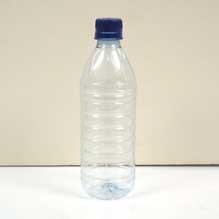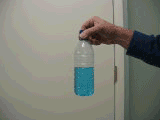Laboratory Flipping the Bottle
Flipping an object is a common human behavior. If someone gave you a stick of wood to play with,sooner or later you would probably try to flip it end over end and catch it. Once you did that successfully, you would probably try other variations, such as catching it after more rotations or flipping it faster or slower. Flipping can be fun!
Sometimes objects do not flip exactly as we expect. This activity is designed to help you explore one such object.
Our Experiment

Tools and Materials
- A small empty plastic bottle with top, for example a 500-ml (17-oz) water or soft drink bottle
- Water
- Optional: different small particles, such as sand, gravel, or marbles, to fill the bottle to the halfway mark
What To Do
- Rinse out the bottle with clean water and then empty it. Shake out all excess water. Replace the cap.
- Hold the cap of the empty bottle in your hand so that the bottle hangs down vertically. Flip the bottle so t hat it turns one and one-quarter times in the air and then catch it with the same hand. The bottle will be horizontal when you catch it. Practice doing this until you can flip and catch the bottle consistently, as shown here. You do not have to toss the bottle high in the air. Rather, begin the toss and then give the end a little extra push to flip it around.

- Next, fill the bottle with water and fasten the top on securely. As in the step above, practice flipping the bottle so that you can catch it easily and consistently after one and one-quarter rotations, as shown in the next video clip. Observe any differences between this and what you experienced when flipping the empty bottle in Step 2.

Be careful—even such a small amount of water is somewhat heavy. Stay focused while flipping the full bottle of water so that you keep it under control.
- Open the bottle and pour out about half of the water. Then fasten the top on tightly once more. Flip the bottle as you have done before, attempting to catch it after one and one-quarter rotations. Observe any differences between flipping a half-full bottle, an empty bottle, and a full bottle. Then take a look at the next video clip to see if your experience was like ours.

- Do you notice any difference in the way the bottle behaves when it is half full of water compared with when it is empty or completely full of water? If so, what explanation can you suggest for this? Discuss this with your friends and work together on a satisfactory explanation.
Hints and Tips
Below are some additional things to try as you develop your explanation.
One idea might focus on the behavior of the water. For example, freeze the half-full bottle of water. Once the water inside the bottle is frozen, try flipping it. Record your observations and compare them with those from the exercise involving flipping the half-full bottle of liquid water. Do the same thing for a bottle completely full of water. What differences, if any, do you see?

You might also explore the effect of varying amounts of water in the bottle. What happens when you flip a bottle with only a little water in it? What happens if the bottle is nearly but not completely full? Do you see any patterns?
What about the material in the bottle? Perhaps replace the water with something that behaves similar to water but in a way that will give you additional clues. For example, fill the bottle full of small particles, such as marbles or gravel, and flip it. Then flip the bottle when it is only half full. Watch the particles closely as the bottle is flipping, especially those in the top layers.
Does the same thing happen when you try to flip a bottle half-filled with sand?
Develop an explanation for what you are observing. Then figure out how you might test this explanation further. Once you have an explanation that is satisfactory to you, send it in along with your test results. Good luck!
What did we find? Take a look at our results [1]. What were your results?
This content has been re-published with permission from SEED. Copyright © 2025 Schlumberger Excellence in Education Development (SEED), Inc.
Course:
- Science [3]
- liquid [4]
